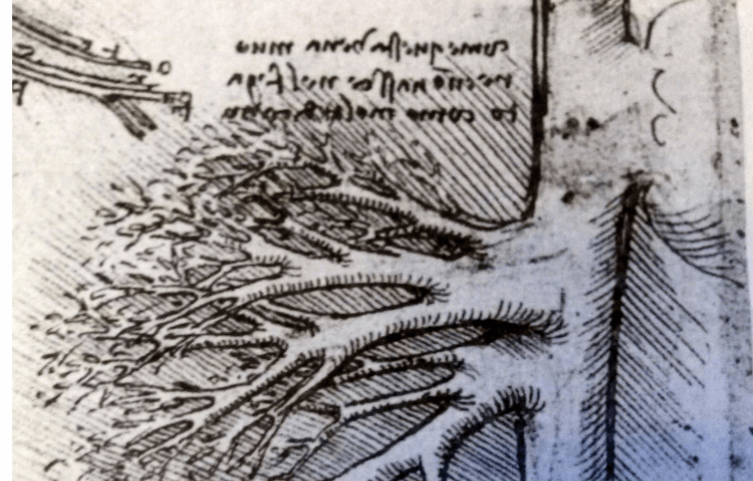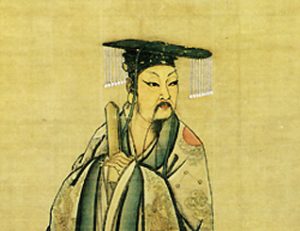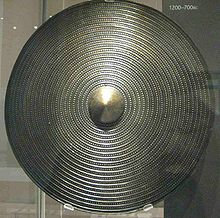In the year 1300, Pope Boniface VIII issued a papal decree, De Sepulturis, which outlawed various methods of lightening the bodies of the diseased for the ease of transport. These methods–common among the Crusaders in the Near East–included the removal of flesh by boiling as well as dismemberment, which also allowed for bodies to be stored in more compact containers. For years after, De Sepulturis was misinterpreted to include the condemnation of anatomical dissection, and for years the study of anatomy would suffer from this misconception. Over time, however, anatomical dissections regained popularity and became important not only to scientists of the body, but also to artists like Michelangelo and Leonardo Da Vinci. However, even into the 1500’s, anatomical sketches were considered distractions unworthy of publication in anatomy textbooks.1

Leonardo Da Vinci, the famous Italian polymath most commonly known today for his painting Mona Lisa, was not renowned for his anatomical diagrams in his time; but unlike his artist peers, his illustrations of the human structure went far beyond the superficial arteries and musculature. While his diagrams do not indicate formal training or even first-hand experience at dissection, Da Vinci began sketching the human anatomy at four different perspectives, simulating a three-dimensional model. Furthermore, Da Vinci sketched the bodily organs, and even wrote about their anatomical functions. It seems that it was Da Vinci’s unquenchable thirst for knowledge and inquiry that drove him to observe deeper than what most deemed necessary. This was characteristic of Leonardo from a young age. Indeed, in 1478, when Leonardo began his career in Florence under the Compagnia de San Luca, he was just sixteen. His early loves for mathematics and mechanics were maintained throughout his life and consistently influenced his vision of the world.4;

Vision was a key aspect to human knowledge to Da Vinci. Being a man of many talents and interests, Da Vinci was drawn to many occupations, and in 1478, after recommending himself to the Duke of Milan, he was made a royal appointee to the duke, Lodovico Sforza, as chief military engineer. In his letter of self-recommendation, Da Vinci referred to himself not only as an artist, but also as a mathematician, architect, and engineer. One of Da Vinci’s first tasks in Milan was to supervise the construction of the Cathedral at Pavia, which would become one of the largest cathedrals in the world. However, it is reported that Da Vinci became so immersed in the theoretical aspects of the physical laws and mechanics involved in the construction of the cathedral that his subordinate had to assume leadership on the practical matters of construction. During this time, Da Vinci also began a practice that has allowed historians and enthusiasts to obtain much deeper insight into the course of Da Vinci’s intellectual studies; like many intellectuals of the Renaissance, Da Vinci began cataloging and recording his studies in notebooks. Many of the anatomical sketches that still survive today were contained in such notebooks. Regardless of his official position as chief military engineer, however, Da Vinci’s primary modes of creation were artistic. Indeed, it was in Milan that Da Vinci finished the paintings Madonna of the Rocks, and The Last Supper; both are masterpieces of human expression and artistic style and technique.5
In 1500, Da Vinci left Milan and continued to paint. He spent several years as a vagabond and finished few paintings during these years, although the famous Mona Lisa was among those left unfinished around the year 1503. At the age of sixty-three, he was appointed to the company of the king of France, near Ambroise, where his chief duty was to keep good company to the king. Leonardo spent the last ten years of his life continuing his research in the realm of the physical sciences, and died on May 2, 1519.6
- Leonardo da Vinci, Leonardo Da Vinci on the Human Body: The Anatomical, Physiological, and Embryological Drawings of Leonardo Da Vinci, eds. Charles Donald O’Malley and John Bertrand de Cusance Morant Saunders (New York: H. Schuman, 1952), 13. ↵
- Leonardo da Vinci, Leonardo Da Vinci on the Human Body: The Anatomical, Physiological, and Embryological Drawings of Leonardo Da Vinci, eds. Charles Donald O’Malley and John Bertrand de Cusance Morant Saunders (New York: H. Schuman, 1952), 131. ↵
- Leonardo da Vinci, Leonardo Da Vinci on the Human Body: The Anatomical, Physiological, and Embryological Drawings of Leonardo Da Vinci, eds. Charles Donald O’Malley and John Bertrand de Cusance Morant Saunders (New York: H. Schuman, 1952), 14-16. ↵
- Leonardo da Vinci, Leonardo Da Vinci on the Human Body: The Anatomical, Physiological, and Embryological Drawings of Leonardo Da Vinci, eds. Charles Donald O’Malley and John Bertrand de Cusance Morant Saunders (New York: H. Schuman, 1952), 14-19 ↵
- Leonardo da Vinci, Leonardo Da Vinci on the Human Body: The Anatomical, Physiological, and Embryological Drawings of Leonardo Da Vinci, eds. Charles Donald O’Malley and John Bertrand de Cusance Morant Saunders (New York: H. Schuman, 1952), 18-21; Toby Lester, Da Vinci’s Ghost : Genius, Obsession, and How Leonardo Created the World in His Own Image (New York : Free Press, 2012), 117-121; Salem Press Biographical Encyclopedia, 2016, s.v. “Leonardo Da Vinci,” by James Livingston. ↵
- Salem Press Biographical Encyclopedia, 2016, s.v. “Leonardo Da Vinci,” by James Livingston. ↵



90 comments
Irene Astran
In your article you write “vision was a key aspect to human knowledge to Da Vinci.” I have to agree with this statement and I feel that the images you featured in this article do adequately show that this is what that man believed. The picture illustrating the artificial vascular system shows just how pertinent detail was to his work.
Johnanthony Hernandez
Amazing article, I always forget the Leonardo Da Vinci was an influential body in the anatomical field and just remember him mostly for his paintings and inventions. Your article did a great job about reminding me that he did this, even if it was against the laws of the Vatican. I think that if he hadn’t gone against the Vatican we wouldn’t have a lot of the knowledge that we do about the anatomy of the human body, and it would have taken longer for us to gain this knowledge. Again amazing article and well written.
Bailey Rider
This areticle is excellent! It was nice to read about and to learn that Da Vinci thought of himself not only as an artist but an engineer, mathematician and architect. You went so into depth and you’re article was really well thought out and well written. He is such an influential figure and the world can learn so much from him. Thank you for the great article!
Tyler Sleeter
Great article with lots of information. I had the pleasure of seeing some of Da Vinci’s science work at a museum once and I as completely in awe of his talents in math and science. I was not aware that artists worked closely with apothecaries at that time period. I also did not know that he had been the chief military engineer nor that he spent his last years in the company of the king. Da Vinci was a true renaissance man with his outstanding work in so many fields.
Alyssa Valdez
I really enjoyed your article and I have to add that I really like the photos you added to your to it. I can tell you put a lot of effort and and research into your article, I found it very interesting. I thought that it gave a very different perspective on Leonardo Da Vinci and his artwork. I also like how he decided to take what he thought was important, no matter how much it was banned, and turned it into his artwork. I thought you did a very well organized Piece. Well done.
Elizabeth Garibay
Amazing article! I never knew anything about Leonardo Davincii but now I am fascinated. I love how he was interested in so many things and it did not matter if he failed or succeeded in some of them . No matter what he wouldn’t give up, he kept on trying and even though he left many of his works unfinished they have some and reason to them. I wish the present education system encouraged innovation so art classes could be better. Although sometimes it just comes naturally to some people.
Mario Sosa
Da Vinci deserves much more credit than just simply being the guy who painted the Mona Lisa. I had known that Da Vinci took interest in anatomy but I never knew how passionate he was about it. It is amazing how he took great interest in so many subjects and managed to excel in all of them. We need more people like him in today’s world. Superb work on the article!
Faisal Alqarni
Hello Christopher, I have always been fascinated by the genius of Leonardo Davincii .He was interested in so many things and it did not matter that he excelled or failed in some of them he kept on trying and even though he left many of his works unfinished he set up the basis for some of the present world’s biggest discoveries as shown by his anatomical dissections and 3d drawings that you mention. I really wish that the present education system encouraged innovation so that the world can have millions of Leonardo Da Vinciis’ I believe it is only through this way of innovation that the world can solve most of its present day and future problems.
Nicolas McKay
This was an amazing article Chris. I knew Da Vinci studied many broad fields, but I had no idea he also delved into anatomy. It certainly seems as if he studied everything that he could, which proved to be a great many things. Its almost sad to think most people remember him solely for his paintings, when he contributed so much to so many other fields. You did a fantastic job telling the history of the subject, and then Da Vinci’s involvement in it. well done.
Briana Bustamante
I was unaware of this side of Da Vinci’s art work. Normally when I think about him, his painting of Mona Lisa comes to mind. The facts and pictures that you provided gave meaning to the article when I was reading it. My favorite interesting fact was when I found out that Da Vinci started painting when he was a little boy. I think back to when I was young and what I was painting, and you could probably not identify what was what. Over all your article was very well written!